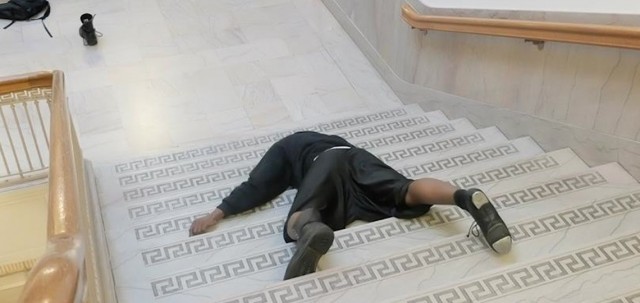
Robert Battle’s AWAKENING is his first new work for Ailey since becoming AAADT artistic director
New York City Center
130 West 56th St. between Sixth & Seventh Aves.
Through January 3, $25-$150
212-581-1212
www.alvinailey.org
www.nycitycenter.org
“All my life I’ve been fascinated by the precipice in all of us. When you come to it, you either choose to fall or you don’t,” Alvin Ailey once said. That theory is still alive and well at Alvin Ailey American Dance Theater under the leadership of artistic director Robert Battle, who took over the reins from Ailey protégée Judith Jamison in July 2011. And it is particularly evident in the new works that Battle has brought into the company, four of which were on display December 17 as part of AAADT’s annual month-long season at City Center. The evening began with Piazzolla Caldera, the second piece by Paul Taylor to enter the Ailey repertoire, following Arden Court in 2011, Battle’s inaugural year. Created by Taylor in 1997 and restaged for Ailey by Richard Chen See, Piazzolla Caldera is a reinterpretation of the tango, set to music by Jerzy Peterburshky and Astor Piazzolla in four sections. On a dimly lit stage with fifteen lighting fixtures dangling from the ceiling at different heights (designed by Jennifer Tipton), the dazzling Linda Celeste Sims is fighting her loneliness as she moves through a dusky nightclub. Men pair up with women, women pair up with women, and men pair up with men — a pas de deux between Daniel Harder and Michael Francis McBride seems to defy the laws of gravity — but Sims can’t find her place, even getting involved in a hard-fought battle with Belen Pereyra over Yannick Lebrun. The brown costumes, with the men in pants and shirts, the women in knee-length dresses, stockings, and heels, are by Oscar-nominated, Tony-winning designer Santo Loquasto. Kyle Abraham, whose Another Night premiered with Ailey in 2012, is back with Untitled America: First Movement, the beginning of a trilogy about the effects of the prison system on families. Set to British soul singer Laura Mvula’s plaintive “Father, Father,” which contains the lyrics “Brother, brother, let me love you / Whisper all your deepest fears, you can trust me / And when it’s over we can begin / Finally to make amends, try to save us,” the stark, spare dance was beautifully performed by Jacqueline Green, Chalvar Monerior, and Danica Paulos, but at ten minutes, it was more of a teaser for what is to come than a self-contained work.

Ronald K. Brown offers up another Ailey treat with the world premiere of OPEN DOOR
Next up was Battle’s Awakening, his first new piece for Ailey since he became artistic director and one that Battle has noted was influenced by Taylor’s Piazzolla Caldera. Set to composer John Mackey’s loud, heavily cinematic “Turning” and “The Attention of Souls,” Awakening is an eighteen-minute sci-fi epic with heavenly overtones that evoke, of all things, Alejandro Jodorowsky’s The Holy Mountain. Wearing all-white costumes by Jon Taylor, twelve dancers come together and drift apart in chaotic fashion, both escaping from and searching for something, with the tall, always impressive Jamar Roberts trying to establish a unique identity away from the pack amid futuristic lighting by Al Crawford that includes a wall that slowly separates to reveal a mysterious glowing horizon. The evening concluded with Ronald K. Brown’s latest piece for Ailey, the sensational Open Door. As he has done with such previous works as Grace and Four Corners, Brown, the head of Brooklyn’s Evidence, a Dance Company, gets the most out of the Ailey dancers, who clearly love performing his West African-based choreography. Open Door is centered by a series of lovely duets by Celeste Sims and guest artist and Ailey rehearsal director Matthew Rushing that go from slow and aching to dynamic and rhythmic, set to four songs by Arturo O’Farrill & the Afro Latin Jazz Orchestra. The colorful costumes by Keiko Voltaire, with the women in long, flowing skirts and the men in tank tops and pants, interact with Crawford’s ever-shifting smoky backdrop. Rushing, Celeste Sims, Roberts, Pereyra, Harder, Akua Noni Parker, Glenn Allen Sims, Rachael McLaren, Vernard J. Gilmore, and Hope Boykin swing their arms, swirl their bodies, leap, kick, and lie on the floor in an energetic and infectious celebration of movement. It was a thrilling conclusion to a wonderful evening of company and world premieres. The all-new program will also be presented on December 22 (with Rennie Harris’s Exodus in place of Piazzolla Caldera), December 26, and January 2; you can also catch Open Door on December 23 and Awakening on December 24.








